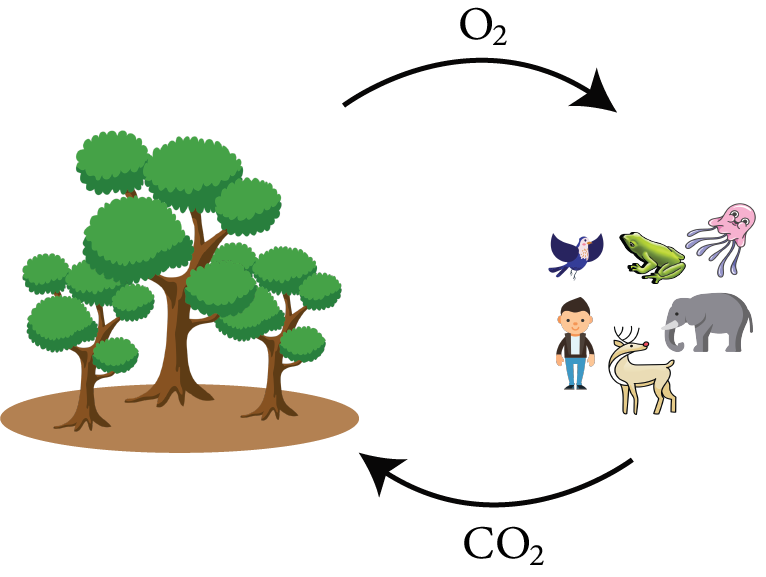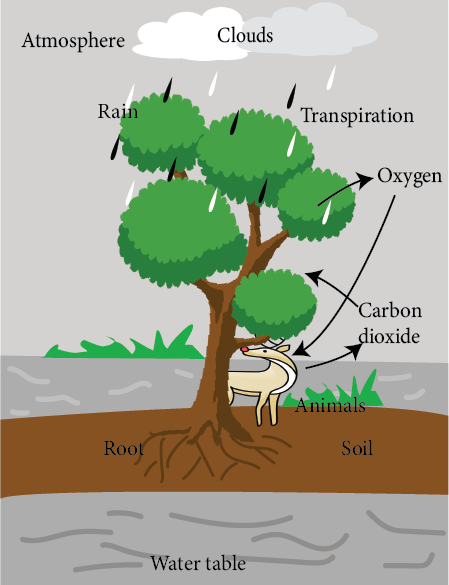Unlock academic success with NCERT solutions for Class 7 Science Chapter 17, a crucial resource for scoring well in CBSE Class 7 school examinations. These solutions serve as a valuable aid, significantly benefiting students throughout their academic journey. NCERT Class 7 Science Chapter 17 provides comprehensive assistance in tackling all questions and problems, ensuring a clear understanding of the chapter’s content.Utilizing these solutions proves instrumental in securing good marks and fostering a strong foundation for students in their academic careers.These solutions are made by some of the expert teachers from across India, and thus it gives confidence to the students to appear in their exams without any fear.
Class 7 Science Chapter 17 – Forests: Our Lifeline at a Glance
This chapter explains the atmosphere and experience of a child who is exploring the forest for the first time with a new friend. Here, you can find the importance of forests and the drawbacks of deforestation.
The forest is a dense land, which is full of biodiversity and also supports the life of various living organisms. The trees in the forest play an important role in maintaining the temperature and environment. The forest takes responsibility to purify the air and provide oxygen for living organisms. They act as excellent sound absorbers.
Trees in the forest also provide firewoods, honey, wood pulp, lac, herbs and medicinal plants, etc. They supply raw materials for many industries and food for animals. Forests act as wind barriers and produce moisture for maintaining the temperature. They also prevent soil erosion and help to protect the fertility of the soil.
Deforestation affects the temperature and impacts climate change. This may lead to a shortage of rainfall and ozone depletion. An increase in the global temperature may result in the melting of glaciers, which will increase the sea level. So, the predominant role of every human being in the world is to protect themselves and the environment.
Access NCERT Solutions for Science Class 7 Chapter 17 – Forests: Our Lifeline
1. Explain how animals dwelling in the forest help it grow and regenerate.
Ans: Forest animals aid in the dispersal of plant seeds. The seed can be fertilized with animal excrement, and the seedlings can grow into plants. Squirrels, bats, and other animals, for example, contribute to seed dissemination.
2. Explain how forests prevent floods.
Ans: Trees help to safeguard the environment in a variety of ways, one of which is flood protection. Without trees, direct heavy rains can deplete the soil and produce flooding, as well as soil erosion. However, tree roots hold the soil underneath and prevent soil erosion. As a result, trees and forests contribute to the prevention of floods in the natural world.
3. What are decomposers? Name any two of them. What do they do in the forest?
Ans: Decomposers degrade substances for sustenance and nutrition, as the name implies. Decomposers, in general, are microbes that break down dead plants and animals to offer and receive nutrients. Fungi and bacteria are two examples of microorganisms.
4. Explain the role of forests in maintaining the balance between oxygen and carbon dioxide in the atmosphere.
Ans:

Maintaining of Oxygen and Carbon Dioxide in Atmosphere
Plants utilize carbon dioxide for photosynthesis and then release oxygen, as we all know. Animals breathe this oxygen and exhale carbon dioxide. The plants then use carbon dioxide, continuing the cycle. As a result, forests contribute to the maintenance of the oxygen-carbon dioxide balance in the atmosphere.
5. Explain why there is no waste in a forest.
Ans: In forests, everything is reused and repurposed. Decomposers are essential in the decomposition of garbage (dead plants or animals). The decomposed trash can be utilized as fertilizer for the development of trees. As a result, there is no waste in the forest.
6. List five products we get from forests?
Ans: Products we acquire from forests include:
- Honey
- Rubber
- Wood
- Medicinal herbs
- Oils
7. Fill in the blanks:
Ans:
- Herbs from the ground layer in the forest.
- A forest is a purifier of air and water.
- The decaying leaves and animals dropping in a forest enrich the humus.
- The insects, butterflies, honey bees, and birds help flowering plants in pollination.
8. Why should we worry about the conditions and issues related to forests far from us?
Ans: Nature has given trees as the biggest gift to all animals on the earth. They contribute to air filtration and the water cycle’s continuation. Forests provide us with a variety of products that we use every day. As a result, we should be concerned about the state of a forest that is far away from us.
9. Explain why there is a need for a variety of animals and plants in a forest.
Ans: It all starts from the food chain. The preservation and survival of a healthy food chain necessitates a diverse range of creatures. Various insects, for example, eat a variety of plants, and those insects are devoured by frogs. The frogs are devoured by snakes, who are eventually eaten by eagles. Everything is interconnected, and each organism has a predator and prey. This is one of several interwoven food chains seen in nature. If one component of the food chain is disrupted, it will have an influence on the others. And a diverse range of plants and animals are required to keep all of these food chains afloat.
10. In Fig 17.15, the artist has forgotten to put the labels and directions on the arrows.
Mark the directions on the arrows and label the diagram using the following labels: clouds, rain, atmosphere, carbon dioxide, oxygen, plants, animals, soil, roots, water table.
Ans:

Atmospheric Components
11. Which of the following is not a forest product?
(i) Gum
(ii) Plywood
(iii) Sealing wax
(iv) Kerosene
Ans: (iv) Kerosene is not a product of the forest. Kerosene is an organic product obtained from the process of distillation of crude oil.
12. Which of the following statements is not correct?
(i) Forests protect the soil from erosion.
(ii) Plants and animals in a forest are not dependent on one another.
(iii) Forests influence the climate and water cycle.
(iv) Soil helps forests to grow and regenerate.
Ans:
(ii) Plants and animals in a forest are not dependent on one another. This is not the right statement as plants and animals are interdependent on each other to fulfill their requirements of growth and development.
13. Microorganisms act upon the dead plants to produce.
(i) Sand
(ii) Mushrooms
(iii) Humus
(iv) Wood
Ans: (iii) Humus. Humus is an organic product formed from leaf litter produced in the soil by the process of microbial decomposition.
NCERT Solutions Class 7 Science Chapter 17 – PDF Download
The PDF of NCERT solutions for Class 7 Science Chapter 17 offers a comprehensive explanation of the topic “Forest: Our Lifeline.” The detailed review includes answers to all exercises, crafted by expert Science teachers nationwide, facilitating an easier learning process. Students struggling with the understanding of Class 7 Chapter 17 can benefit from this PDF, providing a simplified grasp of the topic. Moreover, it presents potential exam questions for CBSE Class 7 Science assessments, serving as a valuable resource for effective exam preparation at any time.
NCERT Solution of Class 7th Science Chapter 17 Forest: Our Lifeline
NCERT solution for Class 7th Science Chapter 17 gives a detailed and proper explanation and overview of the Science Chapter 17 Forest: Our Lifeline. This solution not only makes it easy for the students to understand, but it also reduces the fear of exams. It builds a feeling of self-confidence among the students. The NCERT solution of Science Class 7 Chapter 17 is the key to secure excellent marks as it comes with most of the probable questions that might come in the exams.
Class 7, Chapter 17 of Science, titled “Forest: Our Lifeline,” explores the state of forest lands in our country. It emphasizes the significance of forests in our lives, shedding light on the repercussions of forest depletion on both the environment and human well-being. The chapter unfolds through a field visit to a forest, enabling students to discover the diverse array of plants and animals inhabiting these vital ecosystems. Forests help in maintaining a balance in nature. They have a very important role to play in human lives, and this chapter Forest: Our Lifeline brings the importance of forests to our notice. Forests have different kinds of species that play important role in maintaining the food chain in the forest. The plants in forests are of different kinds such as Medicinal plants, wood and timber. The forest products help to maintain the living standard of human beings. Forests serve as an important habitat to many flora and fauna species and NCERT Class 7 Science Chapter 17 Forest: Our Lifeline explains the importance of these forest covers.
The Class 7 Chapter 17 Science also brings out the effects of deforestation or depletion of forest cover. It depicts how rapid urbanization depletes forest covers and how the animals in that forest suffer. The chapter shows the effects of population growth and rapid construction on forest and environment. With all these things, the chapter also provides certain ways to conserve the forest and maintain a balance in nature.
The NCERT solution of Class 7th Science Chapter 17 guarantees the best result in your school examinations, and it always maintains 100% accuracy.
Benefits of NCERT Solution of Class 7 Science Chapter 17
NCERT solutions Class 7 Science Chapter 17 provides the answer to every question mentioned in Science Chapter 17 of Class 7. It also provides some solved examples for the students to be through with the chapter. This solution gives the students self-confidence and provides them with a better understanding of the chapter. Here we have mentioned some benefits of NCERT Science Class 7 Chapter 17:
- Comprehensive explanations for each exercise and questions, promoting a deeper understanding of the subject.
- Clear and structured presentation for easy comprehension.
- Accurate answers aligned with the curriculum, boosting students’ confidence in their knowledge.
- Visual aids like diagrams and illustrations to simplify complex concepts.
- Additional tips and insights to enhance students’ performance.
- Chapter summaries for quick revision.
- Online accessibility and downloadable resources for flexible study and revision.